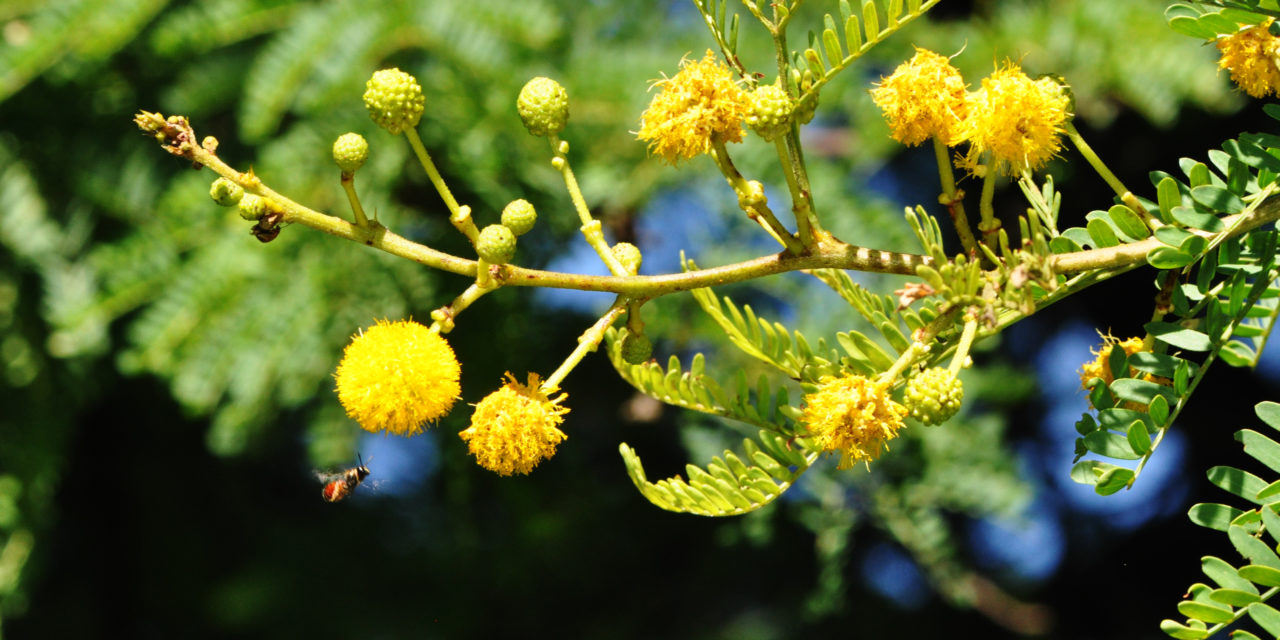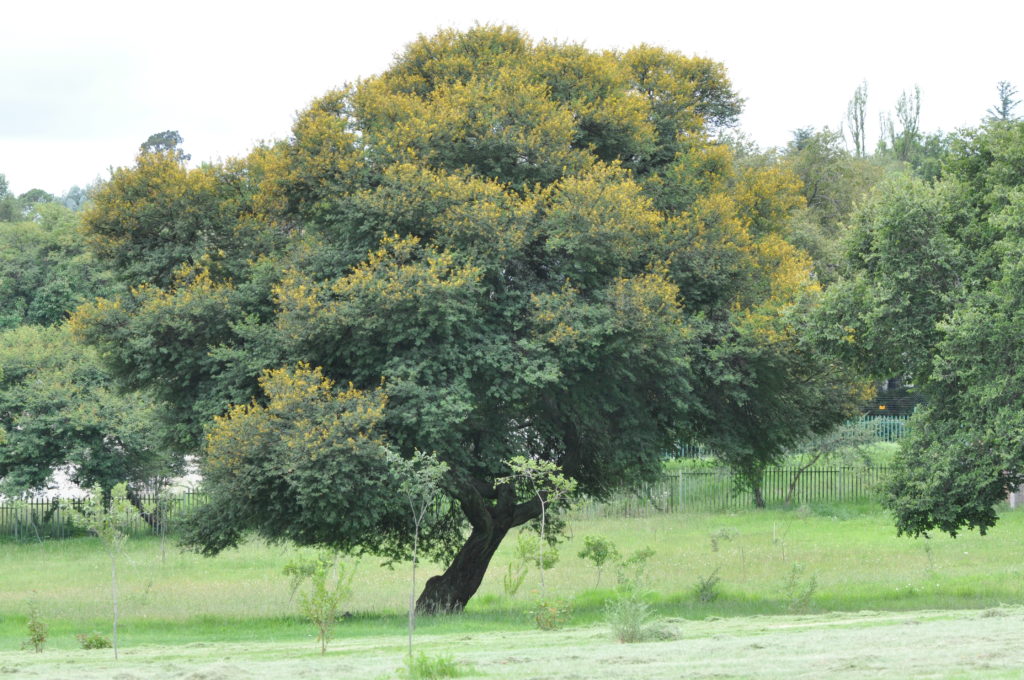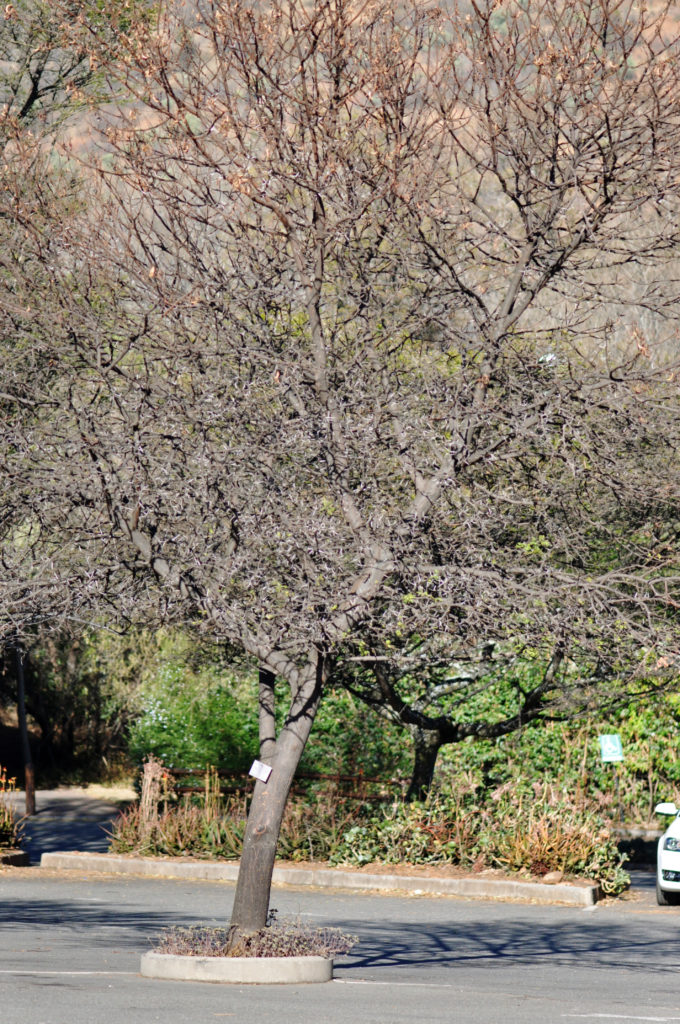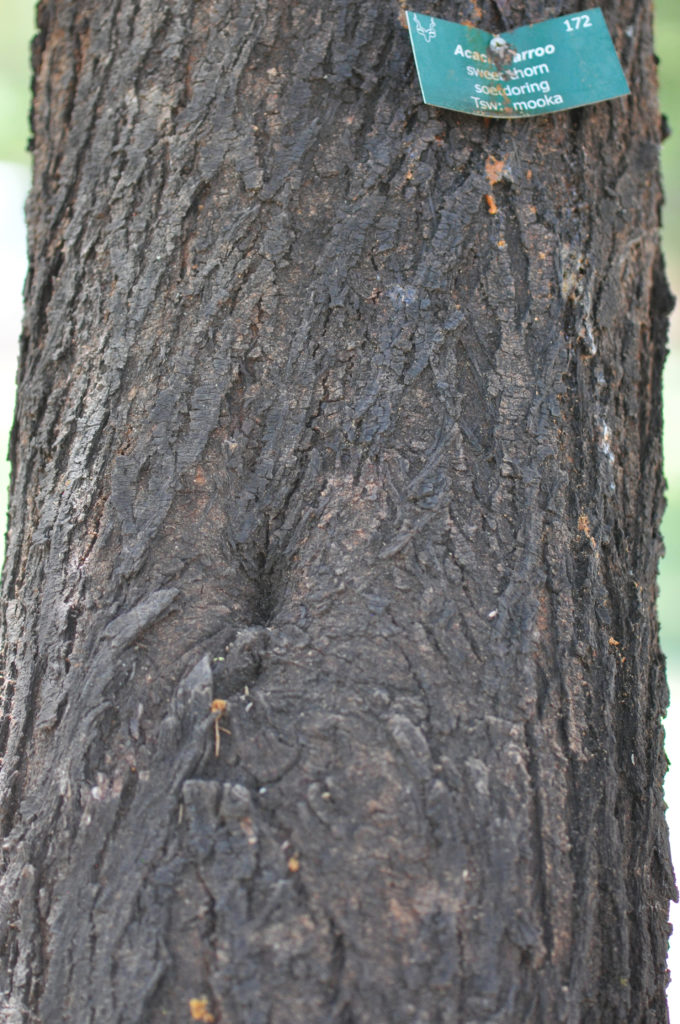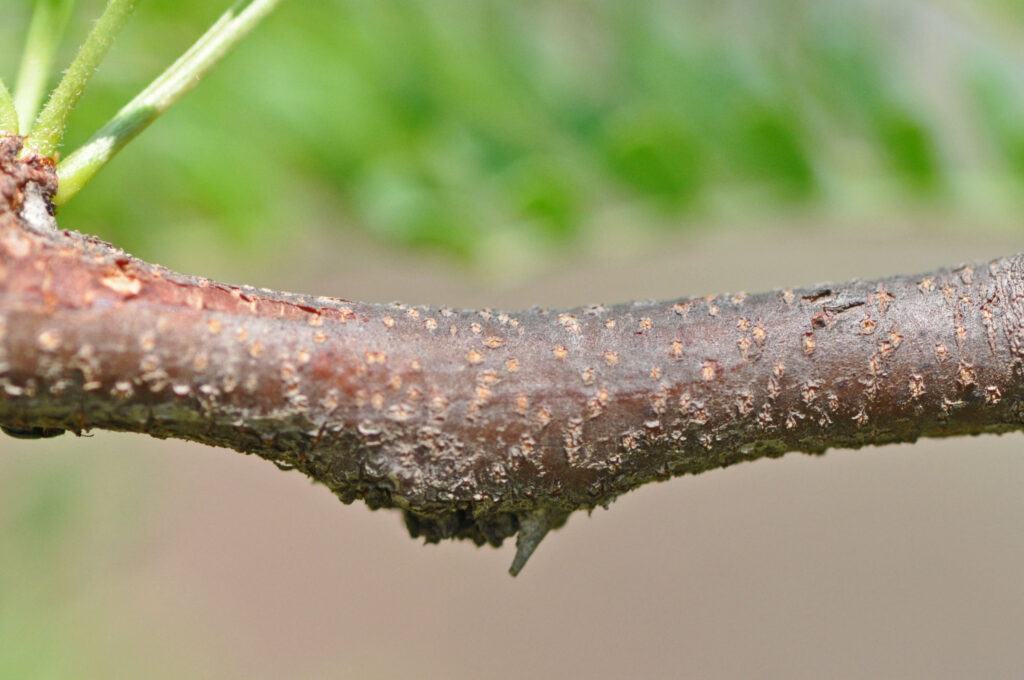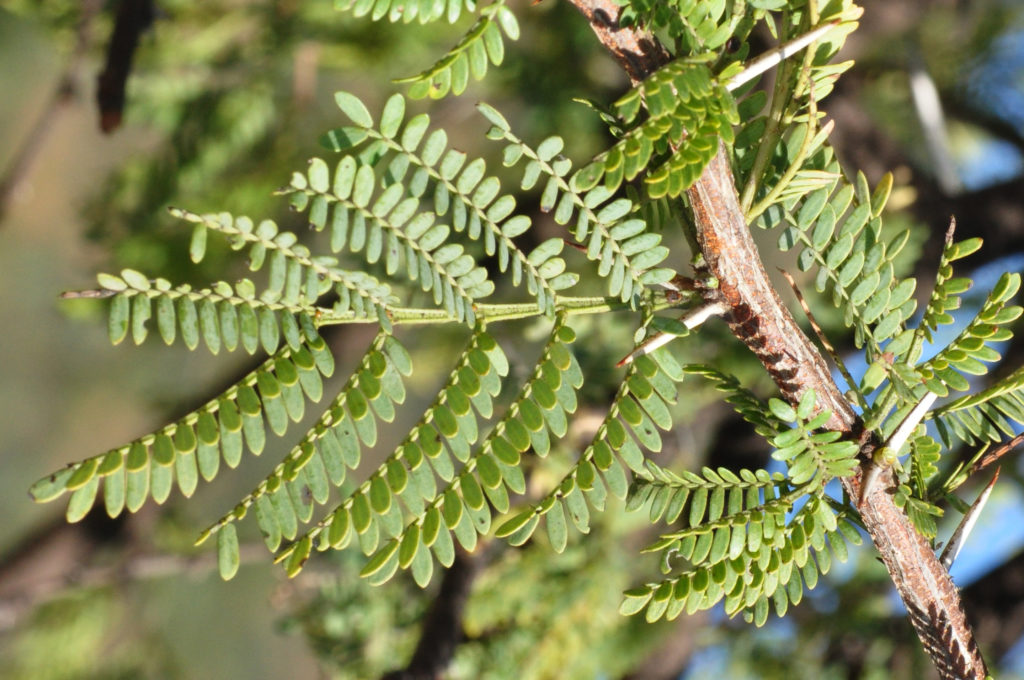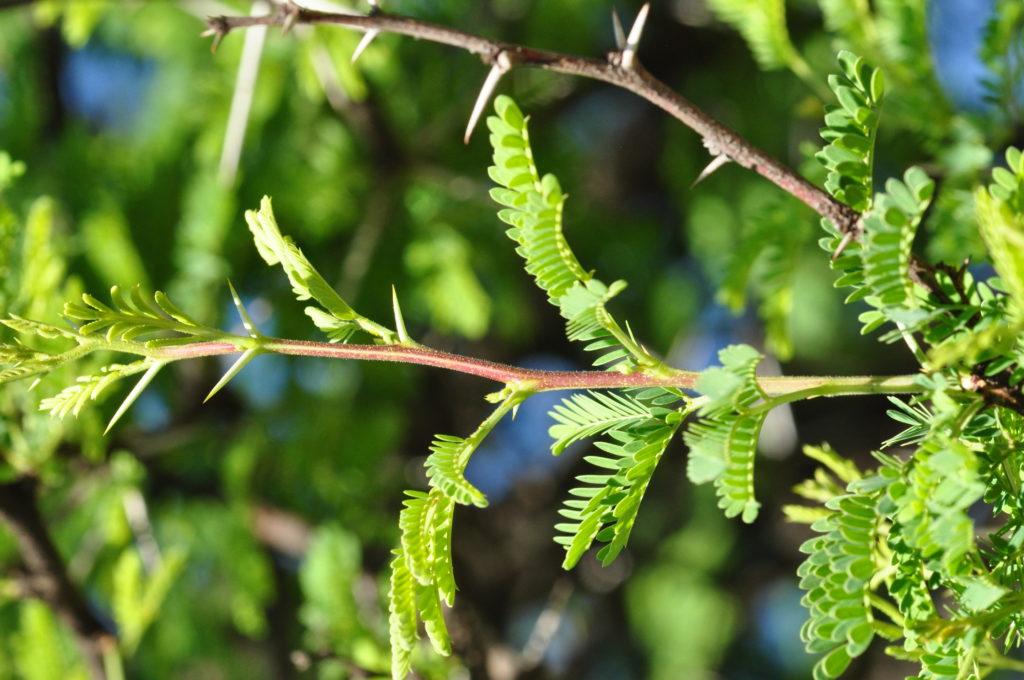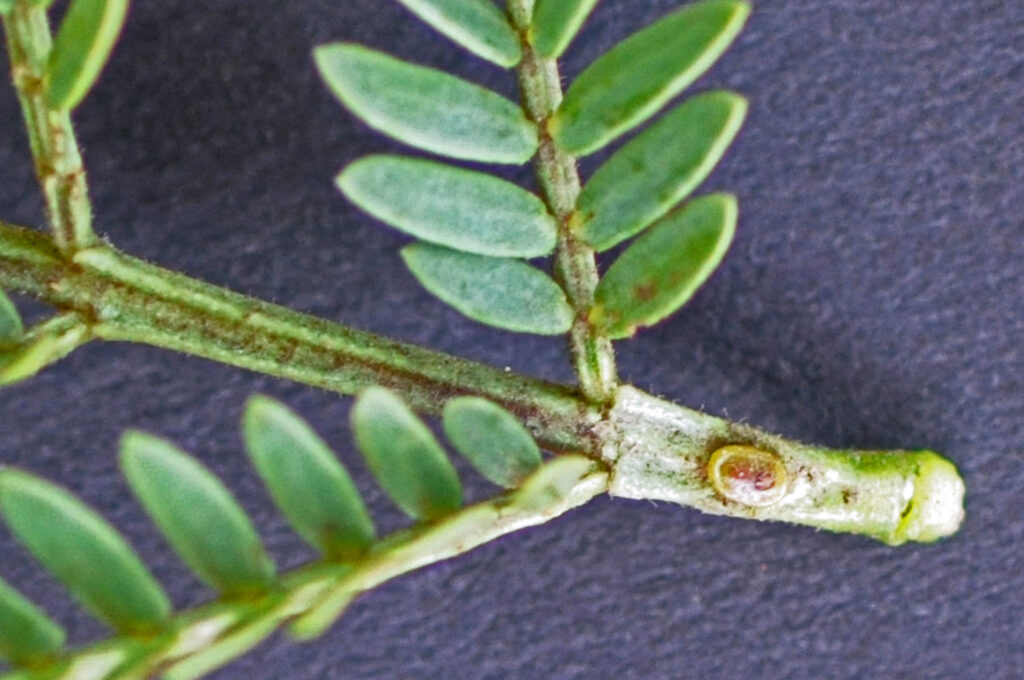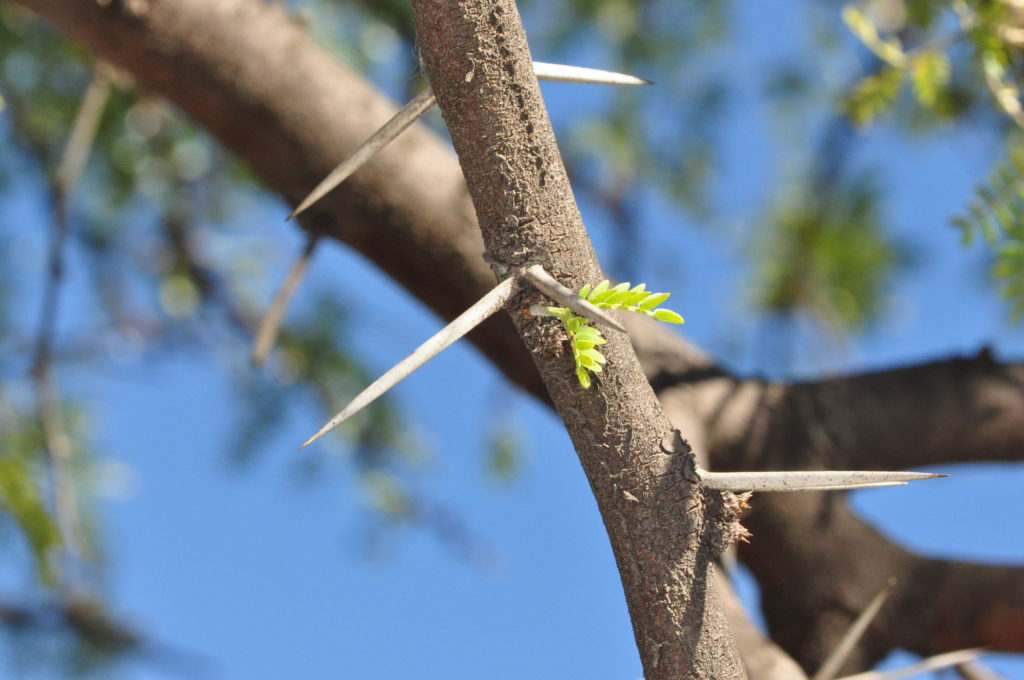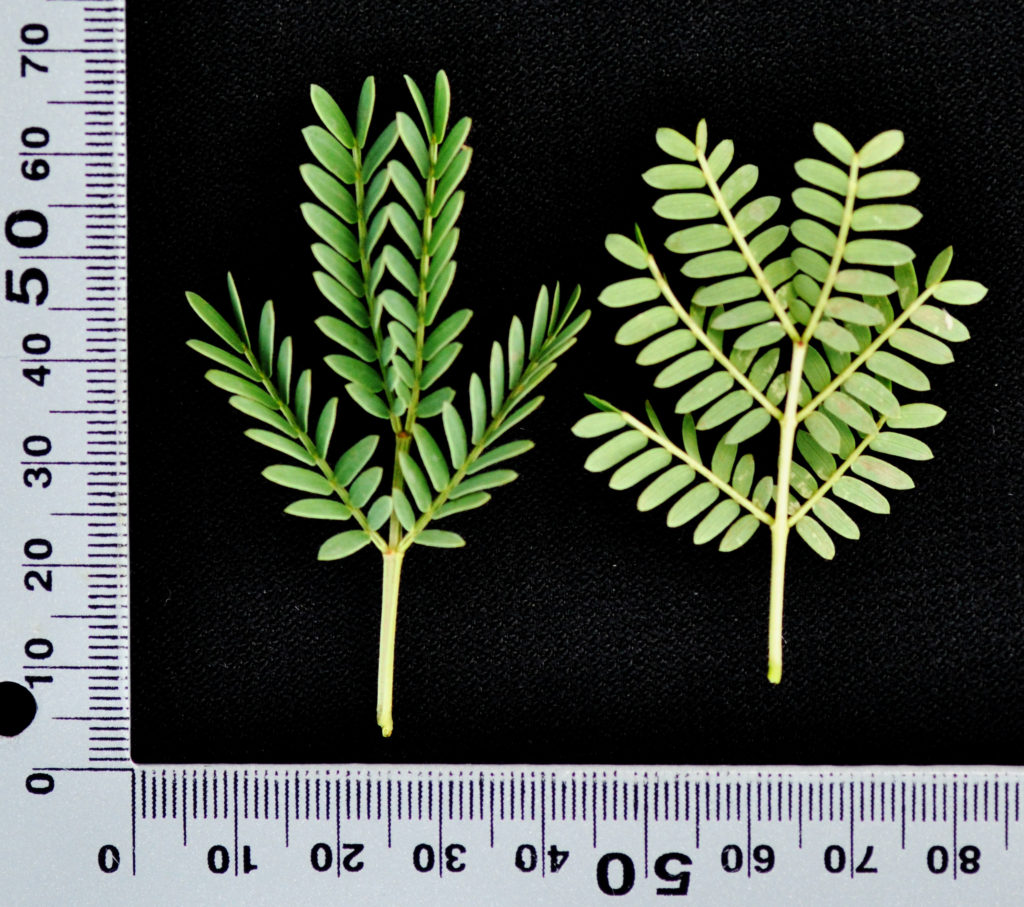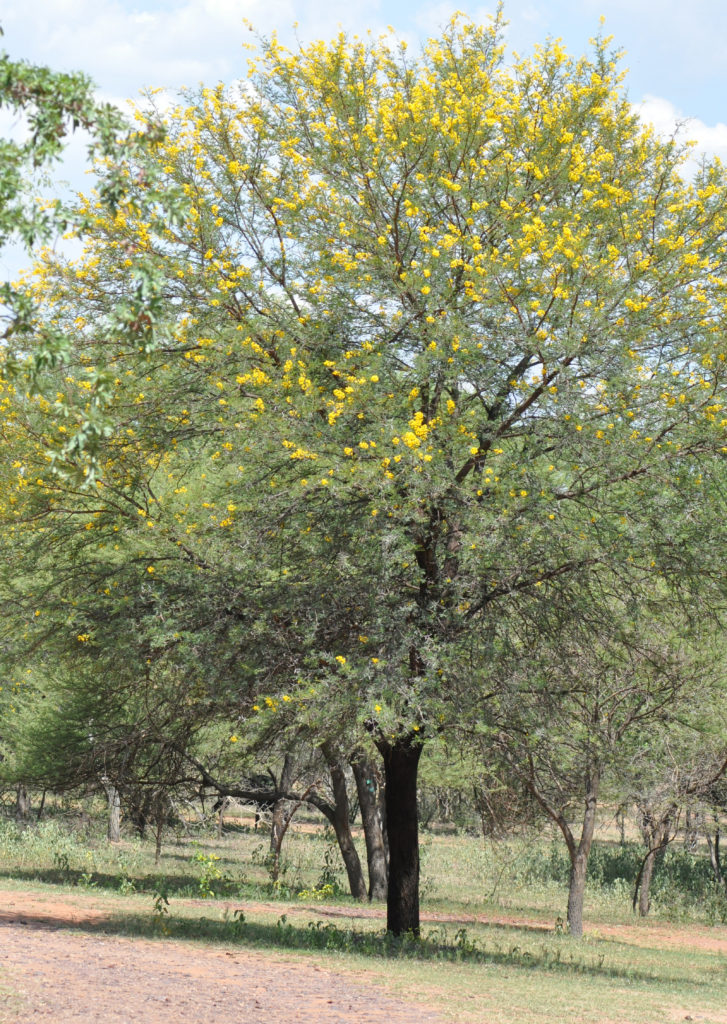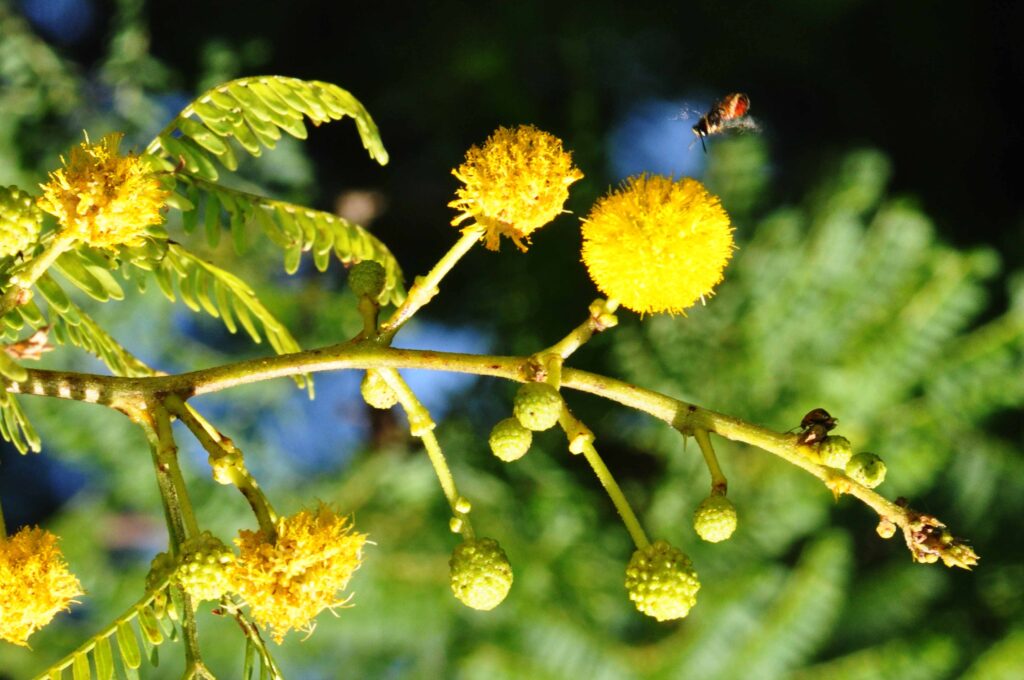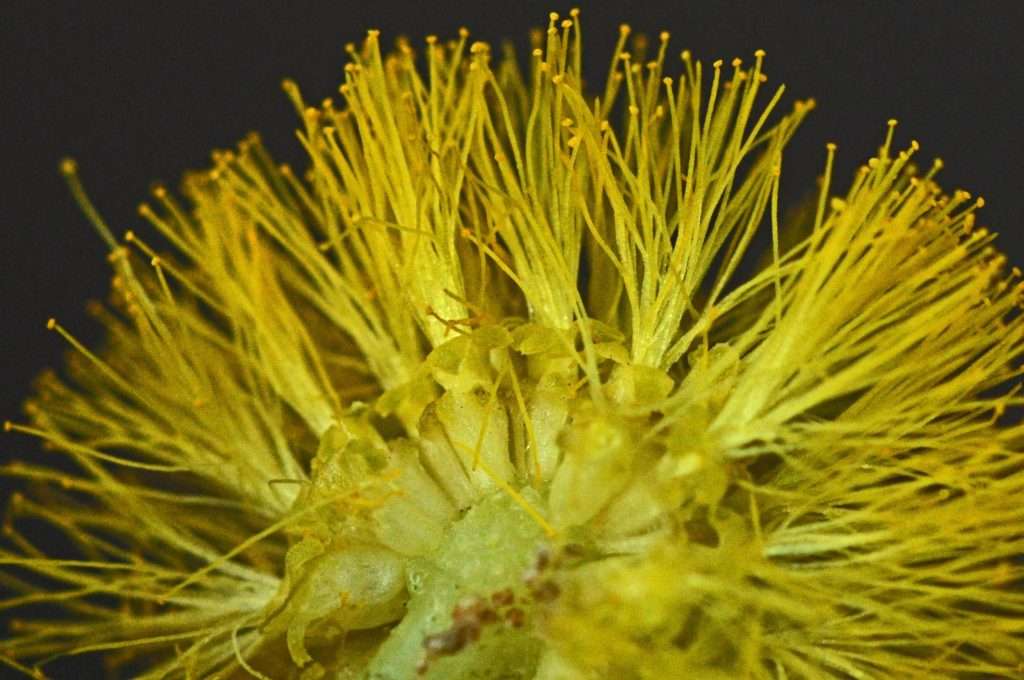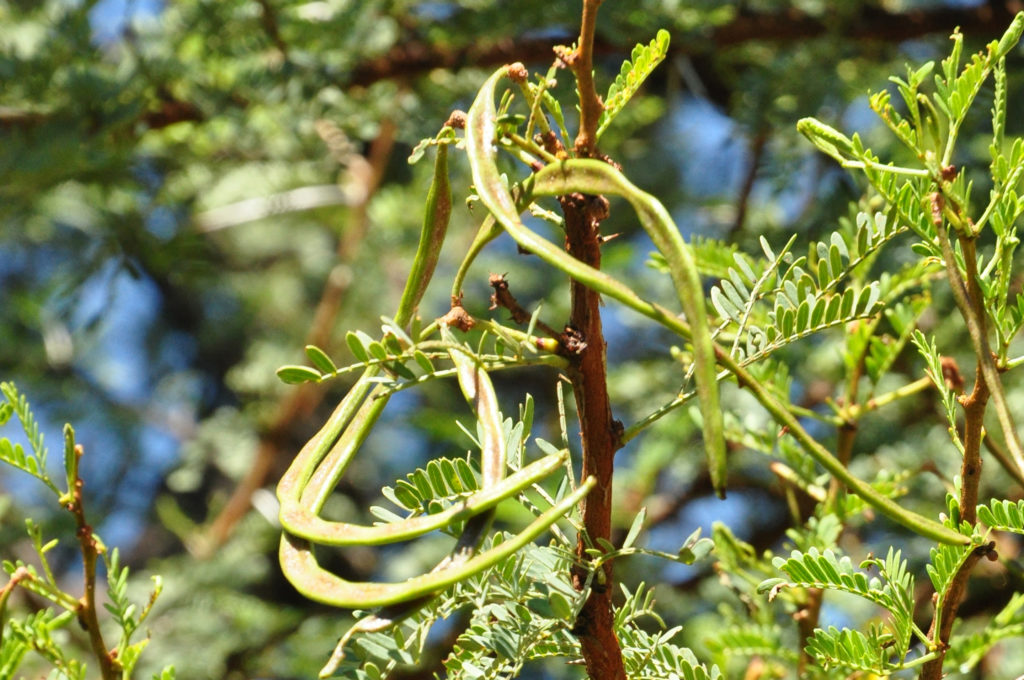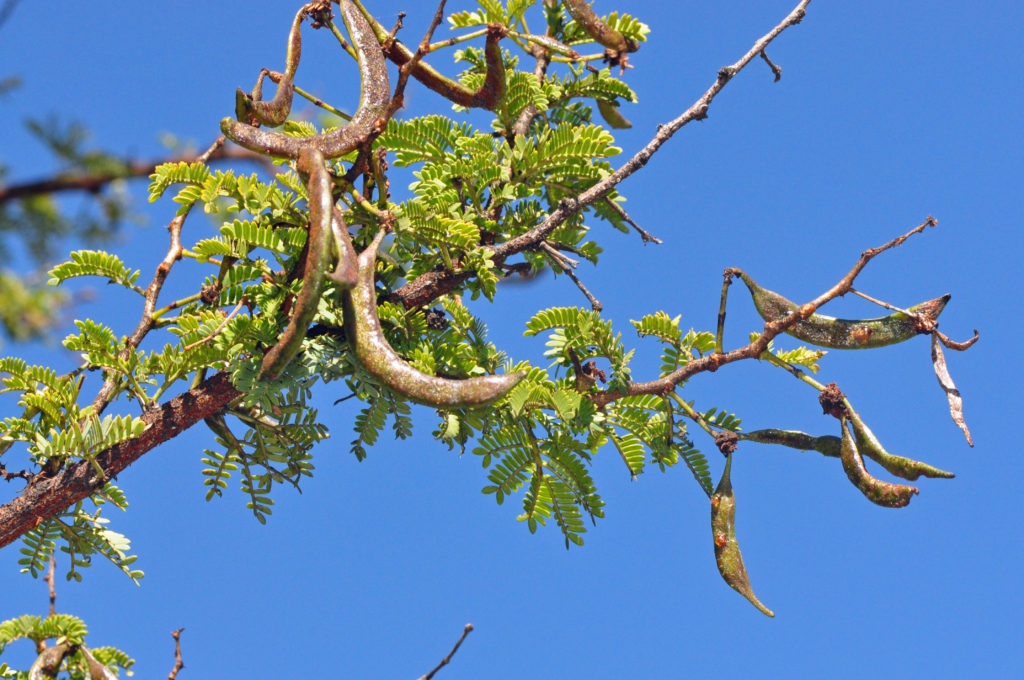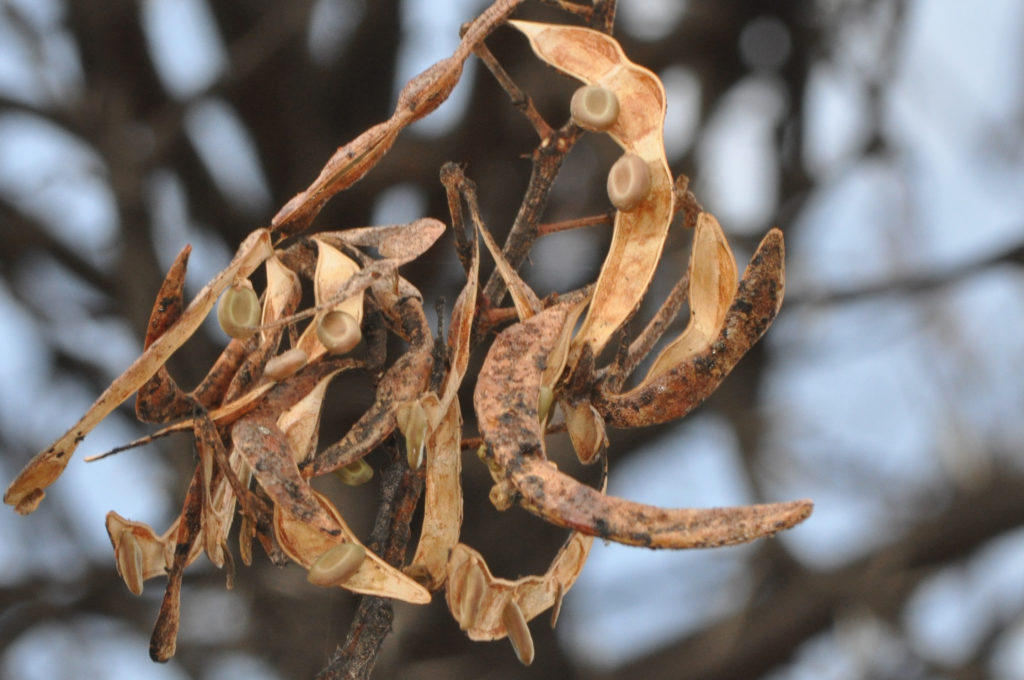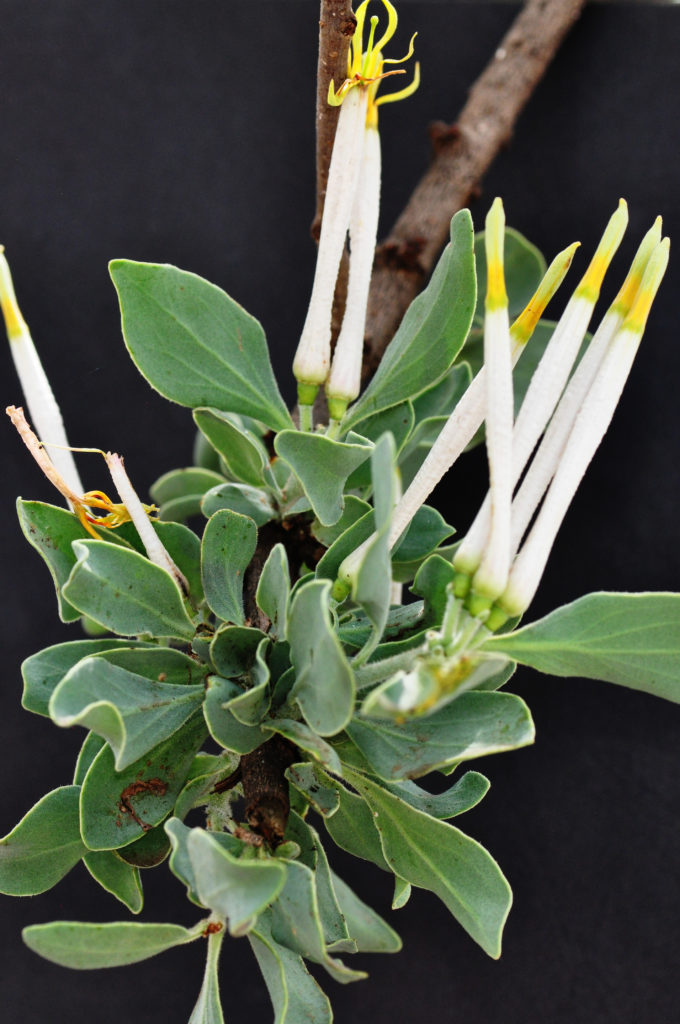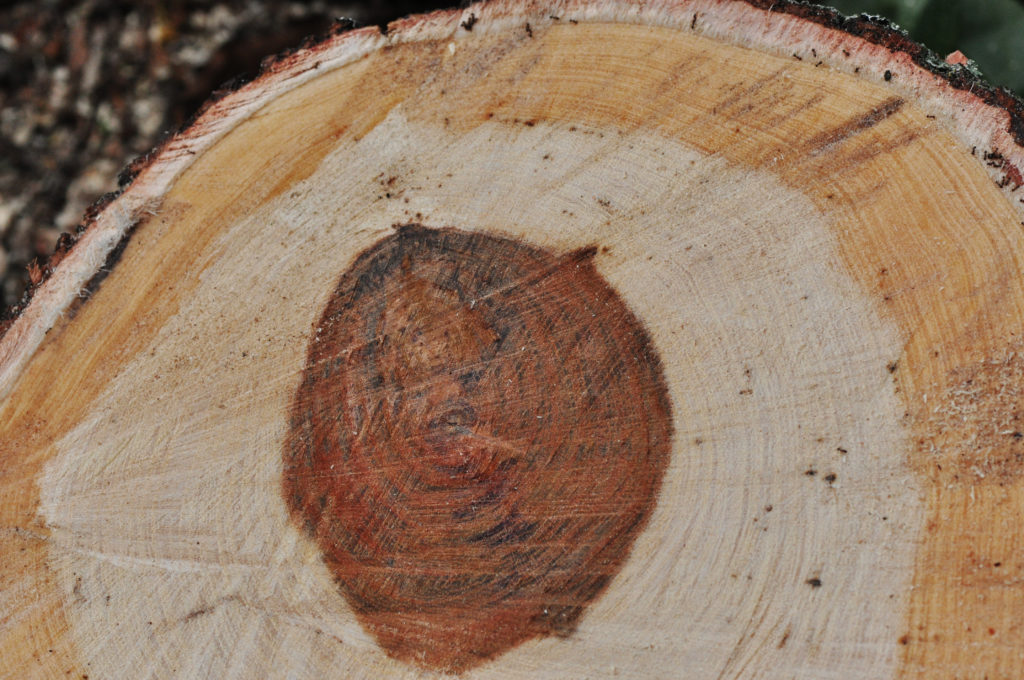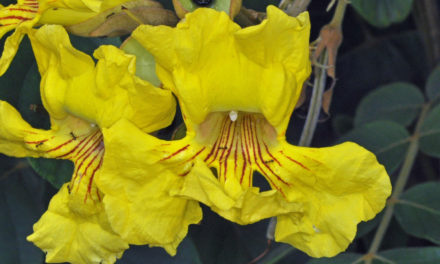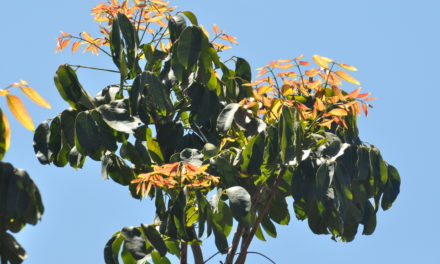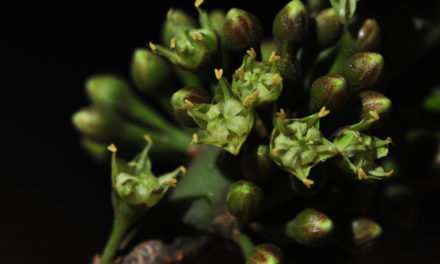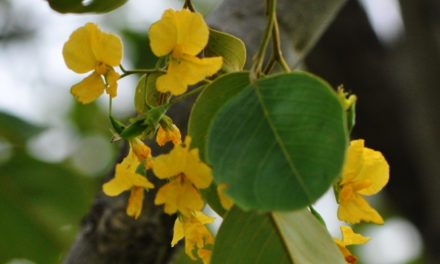General Info – summary
This widely spread Tree is up to 20m high with a spreading rounded crown. The bark can be rough and fissured. Bipinnate Leaves have spinescent stipules and paired white spines. Inflorescence is a compacted spherical branch ends spike, not among the leaves. Each regular, golden yellow 5-merous Flower has many exserted stamens and a superior ovary with a filiform extending style. Fruit is a dehiscent pod with flat seeds.
Description
Vachellia karroo
Previous Names: Acacia capensis, Acacia dekindtiana, Acacia hirtella, Acacia hirtella, Acacia hirtella. var. inermis, Acacia horrida var. transvaalensis, Acacia inconflagrabilis, Acacia karroo, Acacia karroo var. transvaalensis, Acacia natalitia, Acacia reticulata, Acacia robusta. Acacia seyal, Mimosa capensis, Mimosa eburnean, Mimosa leucacantha, Mimosa nilotica, Mimosa reticulate.
SA Tree No. 172.
Common names: (Afr) Fyndoring, Kaapse Doringboom, Doringboom (in a song – see ref), Karoodoring, Karoo-doring, Karoodoringboom, Khoeboom, Khoedoring, Mimosadoring, Mimosadoringboom, Nataldoring, Pendoring, Rivierdoring, Sambreeldoring, Soetdoring, Soetdoringboom, Suurdoring, Swartdoring, Witdoring, Witdoringboom. (Eng) Cape Gum, Cape Mimosa, Cape Thorn Tree, Cape Thorn-tree, Gum-arabic Tree, Karoo Mimosa, Karoo Thorn, Mimosa, Mimosa Thorn, Sweet Thorn, Thhorn Tree, Umbrella Thorn, White-thorn, Whitethorn. (IsiNdebele) Isinga. (isiXhosa) Umnga, Umnga-mpunzi. (isiZulu) Umunga. (Northern Sotho) Mooka, Mookana. (Setswana) Leoka, Mooka, Mookana, Moshaoka, Munga. (siSwati) Isinga. (Tshivenda) Muunga, Muunga-ludzi. (Tsonga) Munga.
Family: Fabaceae or Leguminosae. (Pea, bean or legume family). After the Orchidaceae and the Asteraceae, the Fabaceae is the third largest Angiosperm (flowering plants) family with 700+ genera and close to 20 000 species. Local Tree genera on this website include Acacia (Vauchellia, Senegalia), Albizia, Bauhinia, Bolusanthus, Burkea, Calpurnia, Colophospermum, Cordyla, Cyclopia, Dichrostachys, Erythrina, Erythrophleum, Faidherbia, Indigofera, Mundulea, Peltophorum, Philenoptera, Piliostigma, Schotia and Xanthocercis. The Fabaceae are recognisable by their fruit and their pinnately compound Leaves. Leaves may also be simple – even bilobed and usually have stipules – some of which may be spinescent. Leaflets are usually entire. Flowers are bisexual and bracteate. Regular flowers usually have 4-5 sepals and the same number of petals. Irregular flowers have 4-5 sepals and 5 or less petals. Stamens have anthers that have 2 pollen sacs and there are usually at least twice the number of stamens as petals – often 10. The superior Ovary has one locule that may contain 1 or more ovules. The Stigma and Style are simple. The single carpel develops into the Fruit, which is usually a pod. This pod dehisces on both sides and may break into segments. Seeds vary.
Name derivation. Species of the genus Vachellia and Senegalia were considered members of the genus Acacia until 2005. New Names. The genus Vachellia was named after George H. Vachell (1789 – 1839), chaplain and plant collector in China. Here the inflorescence is capitate (head like) and spinescent stipules are present. Plants in the genus Senegalia – (from Senegal) usually do not have spinescent stipules and the inflorescence is usually a spike. karroo – (incorrect spelling has to remain because it was the first name given). This is the most conspicuous tree of the semi desert.
Conservation: National Status: L C (Least Concern). Assessment: 2005 (W. Foden and L. Potter).
Tree
This Tree is usually up to 8m high but may reach 20m (e.g. in Zimbabwe) or it may occasionally be a several-stemmed shrub. Size is largely habitat dependent. The dense Crown is usually spreading and rounded (photo 854). Branching usually occurs reasonably close to the ground. The trunk may reach 0,6m in diameter but is usually about half this. On the trunk, the coarse Bark is reddish brown, dark brown or black (photo 374). It may be smooth or become rough and slightly fissured. This may expose the reddish non-powdery underbark. Young reddish dark olive-green branches (photo 28 & 40 – under Leaves) are hairless with slightly raised beige Lenticels (a usually raised corky oval or elongated area on the plant that allows the uncontrolled interchange of gases with the environment – photo 28).
- 854. 2018/02/22. Ernest Ullmann. Photo: David Becking.
- 121. 2014/08/26. Walter Sisulu NBG. Photo: David Becking.
- 374. 2014/02/18. Marakele NP. Photo: David Becking.
- 28. 2014/09/23. Walter Sisulu NBG. Photo: David Becking.
Leaves
This often-deciduous tree (photos 121 & 374 above) has bipinnate Leaves (compound: twice pinnate. The central axis or rachis has lateral “branches” not leaflets and the leaflets are on these pinnae “(side branches” – photo 623). The darkish green leaves tend to droop on the tree. The Petiole (leaf stalk) up to 20mm long and is usually grooved above and A Petiolar gland is frequently present (photo 69). The Rachis (main central leaf axis and excludes the petiole – photo 623) is up to 80mm long (photo 52 & 69). Both the petiole and rachis are usually grooved above. Leaves have up to 6 pairs of Pinna (primary segments of a compound leaf containing leaflets). Here each pinna containing 8 to 18 paired and spaced apart Pinnules (Leaflets – photo 623). At higher altitudes more pinnae may develop. Each leaflet is oblong and is usually up to 8 x 3mm. The Apex is rounded to slightly pointed, and the Base is rounded. Glands may appear between leaflet pairs. Stipules (basal appendage of the petiole) are spinescent (develop into spines). At nodes, the young developing paired spinescent stipules are visible (photo 40). The attractive mature stout white and dark tipped Spines are straight or slightly curved (photo 53). They are usually 0,4-10cm long but may reach 20cm in drier areas. Spines may be swollen. More spines occur on the lower branches and, as the tree ages, and new spines may be smaller. The larger spines near the base may reflect an adaptation to restrict grazing. Sticky glands are present on shoots, roots and leaves.
- 52. 2014/04/29. Walter Sisulu NBG. Photo: David Becking.
- 40. 2014/09/30. Walter Sisulu NBG. Photo: David Becking.
- 69. 2014/12/02. Walter Sisulu NBG. Photo: David Becking.
- 53. 2014/04/29. Walter Sisulu NBG. Photo: David Becking.
- 623 2015.10.27 Walter Sisulu NBG. Photo: David Becking.
Flowers
This tree is one of the last Vachellia genera to flower, and flowering is often rain dependent. The spectacular golden yellow fragrant Flowers (photo 375) develop in an inflorescence that is up to 30cm long and occurs at the ends of branches (not among the leaves). It contains up to 7 condensed spherical Spikes (simple indeterminate inflorescence with sessile flowers on a single unbranched axis opening in succession towards the apex – photo 870). Each spike is up to 18mm wide and rests on a hairless Peduncle (the stalk holding the whole inflorescence) that is up to 25mm long. Along each peduncle is a ring of Bracts (usually much reduced specialized leaves in the flower structure). In photo 870, the small rings of bracts on the peduncles are clearly visible. Each golden flower spike is up to 18mm in diameter and spikes develop at branch ends and not among the leaves (photo 870). Each spike has from 34 to 100 small flowers that are bisexual (apart from a few male flowers)
The tiny individual flowers are actinomorphic (Regular, symmetrical. Flowers are vertically divisible into similar halves by more than 1 plane passing through the axis). The Calyx has 5 connate (united or joined) Sepals that are up to 3mm long (photo 45). The Corolla has 5 Petals that are up to 5mm long and valvate (meeting by the edge without overlapping). In both the reflexed lobes are visible (photo 45). The many Stamens are exserted (sticking out; projecting beyond) and have long golden Filaments ending in golden Anthers (photo 45). This, together with the golden sepals and petals, gives the inflorescence its impressive colour. The superior Ovary has many ovules. The Style is filiform (thread or filament like) and eventually extends the small stigma beyond the stamens. This late extension by the style helps to ensure cross-pollination. The tree is typically insect pollinated (photo 870). (Nov-Feb).
- 375 2014.02.18 Marakele NP. Photo: David Becking.
- 870 2014.11.25 Walter Sisulu NBG. Photo: David Becking.
- 45. 2017/11/28. Pretoria NBG. Photo: David Becking. Dissected.
Fruit
The Fruit is a slightly woody Pod, which is initially green (photo 51) but become rusty to dark brown when mature. The hairless pod is usually up to 10 x 0,7cm and dehisces on the tree. The mature pods are slightly constricted between seeds (photo 853) and vary from almost straight to sickle shaped (photos 249 & 51). Up to 10 Seeds develop and u-shaped markings are present (photo 853). They may remain on the trees in open pods for some time. Seeds are flat and elliptic or lenticular and may be olive green to brown (Photo 853). Dispersal is mainly through the gut of ruminates.
- 249. 2014/02/18. Marakele NP. Photo: David Becking.
- 51. 2014/04/29. Walter Sisulu NBG. Photo: David Becking.
- 853. 2015/08/11. Walter Sisulu NBG. Photo: David Becking.
Distribution & Ecology
These widely adaptable Trees are Located in a wide range of vegetation types. Provincially they occur in the Northern Cape, Western Cape (excluding the cold winter rainfall area), Eastern Cape, Free State, KwaZulu-Natal, Gauteng, Limpopo, Mpumalanga and North West. It is most common to the west and south of the Drakensberg. Beyond South Africa, trees occur in Namibia, Angola, Botswana, Malawi, Zimbabwe and Zambia. This is the most commonly visible tree in southern Africa. It grows in a variety of habitats from temperate to the Kalahari a (semi-arid savanna in southern Africa including parts of North West, Botswana, and Namibia – often with visible red sands). The most conspicuous grass found with this tree is the tufted Themeda triandra. This is a blue-green tufted grass, commonly called rooigras or red grass. Vachellia karroo plants also occur in different soil types – including sand dunes and deep clay soils (smaller plants). The tree has a deep tap root system (reportedly in excess of 50m) and, as a result, is often found slightly further away from a water source than other trees in dry areas. The tree becomes a good indicator of where to find water in dry areas. These plants have Coppice Growth (the ability to regenerate from the damaged stump or roots e.g. after a fire). In more moist environments, trees are often associated with Themeda triandra (a blue-green tufted grass). Trees are not common at high altitudes because of sensitivity to frost. They occur from coastal dunes and up to an altitude of about 1 800m. The leaves are poison free.
Many butterfly larvae feed on the leaflets. These include the rare Charaxes zoolina (club-tailed Charaxes in the Eastern Afromontane lowland, and riverine and coastal forests. Another butterfly is Azanus jesous jesous (Topaz Babul Blue) – with a year-round year-round flight period in warmer parts. The widespread butterfly, Azanus ubaldus (Velvet-spotted Babul Blue) have larvae that feed on flower buds and fresh shoots. Apart from highest points and extreme West, it is widespread where-ever Vachellia karroo grow. Pollen is rich in protein and attracts many insects, including bees. The flowers provide good bee food – enabling quality honey production. Insects attract birds like the Grey Louries or Go-away birds (Crinifer concolor). An insect problem may develop from the big cream-colored, sap sucking scale insect Lecanodiaspis mimosa. They have piercing-sucking mouthparts. When present in large numbers they can damage this and other trees. The tree spines offer protection and encourage bird nesting – including by turtledoves and sparrows. Antelope consume the flowers, pods and leaves. The small, stocky Meyer’s Parrots (Poicephalus meyeri subsp. transvaalensis) consumes leaves and hard seeds. A symbiotic relationship, in which both benefit, exists between the roots and a fungus. During this process, atmospheric nitrogen is fixed. In addition to the tree and the fungus, the environment eventually also benefits from the nitrogen. Black rhino consume young twigs. This tree may be subjected to severe attacks by the wattle bagworm Kotochalia junodi. This is a moth species – the female is worm like and incapable of flight. Agelanthus natalitius (photo 669) is a hemi-parasite (a plant which obtains or may obtain part of its food by parasitism, and part by photosynthesizes) with its narrowly cylindrical flowers may occur on the branches. Birds eating the ripe globose red to black ripe fruit aid seed dispersal.
- Possible parasite. 669. 2014/11/18. Walter Sisulu NBG. Photo: David Becking.
Ethnobotany
The Wood is white to slightly yellow, hard and irelatively dense – up to 890kg per cubic metre. At this density, it will just float in fresh water. The wood is used for building but may be sensitive to borer attack. It saws easily, planes to a smooth finish and glues and varnishes well. The wood is used as fuel and makes good charcoal. It burns with little smoke and is odourless. In its lifetime, a tree can produce over a cubic metre of wood. The Bark has been used to make string and strong rope. It has a high level of Tannins – up to 19%, which tan to a red colour. The rough bark shelters insects and they attracts birds. Because of its deep root system, the Trees give a good indication of where to find water. In dry areas, the Tree provides good shade. The inner bark is used to make rope, which, unlike leather, does not stretch when wet. The red-brown Gum is edible – hence the common name “sweet thorn”. It was once exported as Cape Gum. People and animals, including the bush baby, consume the transparent gum. It is also used for glazing pottery. The Spines are used as pegs or pins. Pods, old flowers and young leaves are consumed by stock. This hardy tree is fast growing. Seeds should be soaked in hot water for a while then immersed in cold water, left overnight, planted and lightly covered with soil. Seeds germinate in less than 2 weeks. In over utilized areas the plants may become invasive. This is an excellent fodder tree. The tree may live for up to about 40 years. Best growth is where the annual rainfall is in the 80-90cm range. Roots are invasive – keep clear of buildings. The plants can form an effective brushwood fence. The fallen tree in the photo below was about 40 years old.
Lecanodiaspis mimosae
- 410. 2018/01/16. Pretoria NBG. Photo: David Becking.
References
Boon, R. 2010. Pooley’s Trees of eastern South Africa. Flora and Fauna Publications Trust, Durban.
Burrows, J.E., Burrows, S.M., Lotter, M.C. & Schmidt, E. 2018. Trees and Shrubs Mozambique. Publishing Print Matters (Pty) Ltd. Noordhoek, Cape Town.
Coates Palgrave, M. 2002. Keith Coates Palgrave Trees of Southern Africa, edn 3. Struik, Cape Town.
Foden, W. & Potter, L. 2005. Vachellia karroo (Hayne) Banfi & Gallaso. National Assessment: Red List of South African Plants version 2020.1. Accessed on 2024/02/28.
Lawrence, G. H. M, 1951. Taxonomy of Vascular Plants. The Macmillan Company, New York. Tenth Printing 1965.
Ross, J. H. A conspectus of the African Acacia Species. 1979. Botanical Research Institute.
Palmer, E. & Pitman, N. 1972. Trees of southern Africa. Balkema, Amsterdam, Cape Town.
Schmidt, S. Lotter, M. & McCleland, W. 2002. Trees and Shrubs of Mpumalanga and the Kruger National Park. Jacana, Johannesburg.
van Wyk, B. & van Wyk, P. 1997 Field guide to Trees of Southern Africa. Struik, Cape Town.
http://plantzafrica.com/plantab/acaciakar.htm
https://en.wikipedia.org/wiki/Vachellia_karroo
http://www.worldagroforestry.org/treedb/AFTPDFS/Acacia_karroo.PDF
http://powo.science.kew.org/taxon/urn:lsid:ipni.org:names:77087189-1
http://posa.sanbi.org/flora/browse.php?src=SP
Host specificity of the hemiparasitic mistletoe, Agelanthus natalitius. (ukzn.ac.za)

